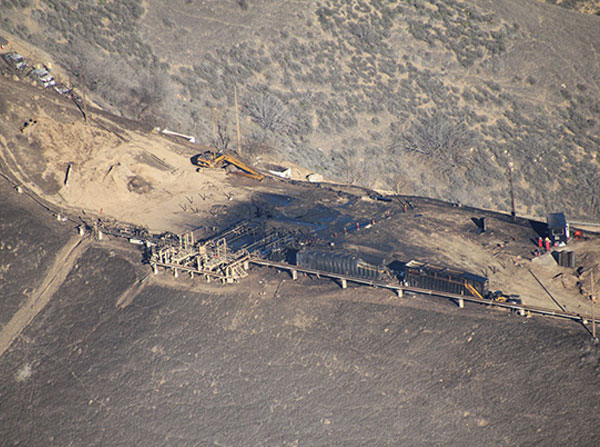
This December photo shows the leaking Aliso Canyon well pad that is olluting the Porter Ranch community in Los Angeles County.
A massive methane leak in a Los Angeles County community will have long-term health consequences that USC researchers said they intend to study.
More than 87,500 metric tons of methane have leaked from a natural gas storage facility near Porter Ranch, according to the Environmental Defense Fund.
Ed Avol, MS, professor of clinical medicine in the Department of Population and Public Health Sciences of the Keck School of Medicine of USC, is an expert on respiratory health and the public health impacts of air pollution.
Avol said he and his colleagues will study the long-term health effects of the natural gas leak in Aliso Canyon.
Question: Gas leaks happen often. Why is this one unusual?
Ed Avol: Methane gas has been spewing out at several thousand pounds per square inch since late October. It is coming out at a very high pressure and this exhaust is expected to continue for another month or two. In terms of climate change and global warming, I have seen estimates claiming that it has increased California’s methane emissions by 25 percent.
In some ways, the Aliso Canyon gas leak parallels the Deepwater Horizon oil spill in the Gulf of Mexico back in 2010. A blowout of a well is exuding a contaminant at great volumes for many months over a wide area, and we can’t do much about it. The Southern California Gas Co. is trying to fix the problem but can’t do it very quickly. So it will continue to be a source of contamination for months.
Q: The people who continue to live and work in the Porter Ranch area are breathing in a lot of methane gas. This can’t be healthy.
A: Right now, we don’t think the methane exposure is as much an issue as some of the other contaminants and the potentially toxic chemicals that may come from byproduct reactions.
Q: What causes the nausea, headaches, eye irritation, nosebleeds and other symptoms Porter Ranch residents are reporting?
A: Methane makes up about 90 percent of natural gas. Methane and other chemicals emitted in natural gas can react in the open-air environment and create other gases and chemicals, such as hydrogen sulfide. Benzene, toluene, ethylbenzene and xylene also have been associated with the emission and are thought to be part of the oily residues in the well and on the walls of the storage facility.
Researchers at USC are interested in investigating these chemical constituents and the long-term effects that might result from breathing in these chemicals.
Q: What is the main chemical causing these adverse reactions?
A: Natural gas is colorless and odorless. Gas companies add methyl mercaptans to natural gas, causing it to smell bad so that people could detect a gas leak at very low concentrations. Methyl mercaptans and other odor markers can break down to form other chemicals in the atmosphere. It is these mercaptans and their possible byproducts that may be a health concern.
A number of agencies are following the odorous agents used to “mark” the gas — tertiary butyl mercaptan and tetrahydrothiophene — as acute agents of concern, but we wonder if there are long-term, low-level effects associated with extended exposure that are not being followed or being seriously considered. We do not believe these have been systematically addressed.
Q: What are some possible long-term health problems?
A: The issues we usually consider run the whole gamut from respiratory to cardiovascular to potentially neurological. Stress also is a concern. If there is a lot of stress, it triggers generic inflammation mechanisms in your body, which may lead to physical biological responses.